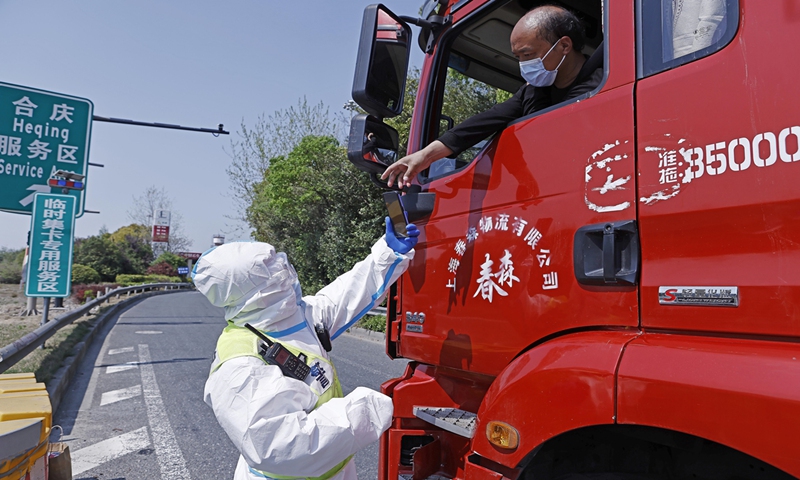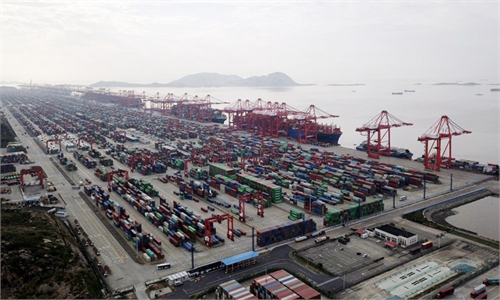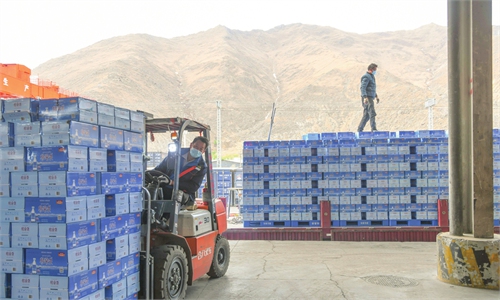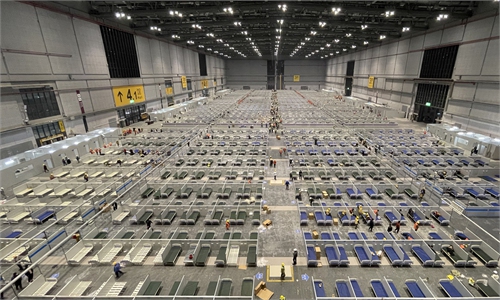Local govts remove logistics barriers after officials stress smooth freight transportation

A policeman checks the nucleic acid test result of a truck driver at Heqing expressway service station in Shanghai, on April 11, 2022. Photo: VCG
Many provinces and municipalities reopened expressways after China's top economic planner urged for smooth transport on Sunday, in a bid to guarantee supplies for people's livelihoods, especially in COVID-hit regions, and support supply chains.
The central government on Thursday again called for smooth freight transport, and it ordered the establishment of a unified and standardized road freight pass system to ensure the transport of key supplies.
Expressway closures in some places have been reduced and the overall traffic congestion in the country has been eased, He Dengcai, deputy director of the China Federation of Logistics and Purchasing (CFLP), told the Global Times on Thursday.
As of Tuesday, the number of closed expressway toll stations had been reduced to 517, accounting for 4.79 percent of all toll stations.
For service stations, the number fell to 283, accounting for 4.28 percent of the total. Seven provinces and municipalities had opened all expressways as of Tuesday, according to the Ministry of Transport (MOT) on Thursday.
East China's Jiangsu Province, located in the epidemic-hit Yangtze River Delta, had reopened 52 highway crossings by Wednesday, accounting for 40 percent of closed expressway passages.
Currently, some intra-city and intra-provincial logistics, especially in industrial parks, have recovered to at least 50 percent in epidemic-hit regions.
Congestion in the logistics business has eased to a great extent since the central government mandated the unblocking of logistics facilities, a manager surnamed Zhao of a Shanghai-based logistics company told the Global Times on Thursday.
The National Development and Reform Commission, the country's top economic planner, held a meeting on Sunday with the CFLP and 10 major logistics companies, saying that it would actively coordinate relevant departments for the full restoration of logistics operations.
On Monday, the MOT deployed local transport authorities to quickly carry out self-inspection and self-rectification of the closure of expressway service areas and toll gates, to further coordinate COVID-19 prevention and control, and ensure access to highways, so as to serve steady and sound economic and social development.
"In the past month, many places barred cargo trucks from [epidemic-hit] Shanghai from entering their jurisdictions. But now there is basically no such issue," Zhao said.
Road congestion is now eased, and the average waiting time to get off the highways is reduced to about six hours from two-three days, Zhao said.
Highway passes have been reopened to trucks from outside of East China's Zhejiang Province, a manager surnamed Pan of a Ningbo-based logistics service company told the Global Times on Thursday.
"But drivers still cannot get out of their trucks due to epidemic controls. Otherwise, they may face a 14-day quarantine," said Pan.
A truck driver in the logistics business in the Yangtze-River Delta told the Global Times on Thursday that most of the highway exits and highway service areas are now accessible to truck drivers as a result of the government notice on Monday.
Truck drivers still need to provide 48-hour or even 24-hour nucleic acid test results and passes from local authorities to meet epidemic control requirements, which has become a big problem for truckers, industry sources said.
Local governments have set up temporary nucleic acid test venues at expressway service stations to solve the problem, as truck drivers handle more than 70 percent of China's road freight transportation, according to statistics from the MOT.
For instance, East China's Shandong Province has established 233 nucleic acid test points on expressways, 45 on trunk highways, 55 on rural roads, 11 at port areas and 34 at airports.
Nucleic acid test processes have been optimized. In Chengdu, Southwest China's Sichuan Province, for example, after finishing a nucleic acid test, drivers can move on with a negative antigen test result, which only takes 15 minutes.
According to He, the main problem now is how to simplify the epidemic prevention procedures for front-line employees, such as couriers and truck drivers, while preventing the spread of COVID-19.
This is of great importance because China has nearly 11 million freight vehicles in operation, and more than 17 million road freight workers, according to the latest statistics from the MOT.




